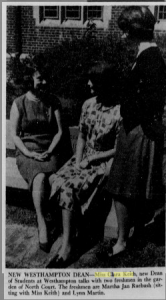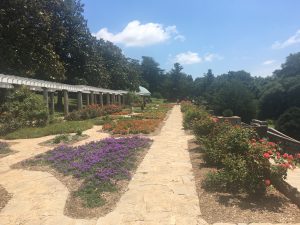by Elizabeth Mejía-Ricart
How many times have you employed the term “slave” to refer to individuals whose identities would seem to rely on their status as property? Even I have been guilty of using this term multiple times to describe what really are “enslaved people.” Before my first encounter with founder of Untold RVA and community historian, Free Egunfemi, I would have never come to realize the ease with which I used what she calls “the language of the oppressor,” instead of that of the “oppressed.” Indeed, employing words such as “slaves” and “masters” to define groups of people allows for a dehumanization of the institution of slavery, and at the same time, reduces enslaved individuals to the position they held in society, treating them as property instead of people.
As part of Team 2 of the Race & Racism in the University of Richmond project, I have the opportunity to collaborate and work directly with Egunfemi, who aims to spread history throughout the Richmond community about the oppressed. In particular, I have paid close attention to the language she utilizes to empower those whose history has been silenced. As I began conducting research, I have kept Egunfemi’s careful wording in mind, and at the same time her themes of self-determination, resistance, and intersectionality in order to continue her mission of retelling history from the point of view of the oppressed.
My initial involvement in the project has included a close reading and examination of the book Rearing Wolves to Our Own Destruction by Midori Takagi. Fortunately, I was pleased to read stories of the oppressed uncovered by the aforementioned author. Takagi’s text clearly fits the guidelines given by Egunfemi for conducting research, giving enslaved persons a leading role in the history of slavery in Richmond. At the same time, her book highlights enslaved people’s self-determination, resistance, and the different ways slavery affected individuals according to their gender and other identities.
Although to the naked eye this book might seem a perfect example of what our team members are trying to document as activists and archivists, there is an important aspect which the book is lacking— the use of the language of the oppressed in the retelling of this group’s history. While I read Tagaki’s text, I could recognize that even though the author was narrating the story of an oppressed group through their own lenses, she was employing the language of the dominant race. Thus, my job as an archival activist was not done. It was my duty to tell the stories of marginalized groups such as enslaved persons, and document their histories of injustice using the terminology of the oppressed. I continued to document the anecdotes uncovered by Takagi in her book, but the keywords associated with the narrative were those that would paint a more vivid picture of the institution of slavery and that would portray these marginalized groups as people whose identities extend beyond their position in society.
Keywords such as enslaved person, human captor and human trafficker are the ones being used by Team 2 in an active effort to replace terms commonly employed in portraying the history of slavery, such as slave, master/owner, and slave trader. The language we are trying to perpetuate is one that not only emphasizes the severity and solemnity of the institution of slavery, but also acknowledges the individuals’ identity beyond the latter institution. Through our understandings of critical race theory, we recognize the prevalence of white privilege in the American society. The dominant classes have shaped the archival records for centuries, and therefore, they have imposed the language commonly used nowadays to refer to these stories. It is only fair for us, as collaborators of Untold RVA, to communicate those narratives that have been buried and unrecorded by the privileged groups, in a way that will honor the marginalized and resist the systems of dominance and oppression.
Ultimately, language is a powerful tool that can shape our conception of society, including the perpetuation of systems of oppression. In order to effectively challenge these structures and bring about social justice we need to start with a change in our expressions, supporting and validating those that have been silenced and oppressed. So, before you use the word “slave” or “master” again, ask yourself: Who am I empowering?
Elizabeth Mejía-Ricart is from Santo Domingo, Dominican Republic. She is a rising sophomore at the University of Richmond who is planning to major in Economics and minor in Mathematics. Elizabeth is a Boatwright and Oliver Hill Scholar, who is part of the University Dancers Company on campus. This is Elizabeth’s first experience as an A&S Summer Fellow, however, she is excited to discover more about the University of Richmond’s history and about the city itself through Untold RVA and her collaboration with Free Egunfemi.



